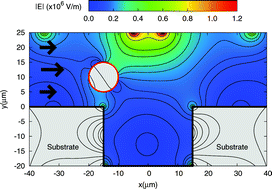Numerical design of electrical-mechanical traps†
Abstract
We present a coupled immersed interface method-boundary element method (

* Corresponding authors
a
Singapore-MIT Alliance, E4-04-10, 4 Engineering Drive, Singapore
E-mail:
smaldv@nus.edu.sg
b
Institute of High Performance Computing, 1 Science Park Road, #01-01 The Capricorn, Singapore
E-mail:
carlos@ihpc.a-star.edu.sg
c
Department of Mechanical Engineering, National University of Singapore, Kent Ridge Crescent, Singapore
E-mail:
mpekbc@nus.edu.sg
Fax: +6567791459
Tel: +6568742889
d
Department of Aeronautics and Astronautics, Massachusetts Institute of Technology, 77 Massachusetts Ave, Cambridge, MA, USA
E-mail:
peraire@mit.edu
We present a coupled immersed interface method-boundary element method (

 Please wait while we load your content...
Something went wrong. Try again?
Please wait while we load your content...
Something went wrong. Try again?
D. V. Le, C. Rosales, B. C. Khoo and J. Peraire, Lab Chip, 2008, 8, 755 DOI: 10.1039/B718153A
To request permission to reproduce material from this article, please go to the Copyright Clearance Center request page.
If you are an author contributing to an RSC publication, you do not need to request permission provided correct acknowledgement is given.
If you are the author of this article, you do not need to request permission to reproduce figures and diagrams provided correct acknowledgement is given. If you want to reproduce the whole article in a third-party publication (excluding your thesis/dissertation for which permission is not required) please go to the Copyright Clearance Center request page.
Read more about how to correctly acknowledge RSC content.
 Fetching data from CrossRef.
Fetching data from CrossRef.
This may take some time to load.
Loading related content
